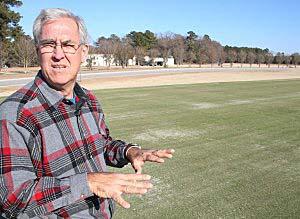 BASF research scientists recently gave an early glimpse into what likely will be the centerpiece of the company's booth at next year's Golf Industry Show in Orlando, Fla.
BASF research scientists recently gave an early glimpse into what likely will be the centerpiece of the company's booth at next year's Golf Industry Show in Orlando, Fla.Xzemplar and Lexicon Intrinsic fungicides, both of which are awaiting EPA approval, have been in testing for the past five years, and both offer control over a broad range of turf diseases, according to scientists discussing the new products at the annual American Phytopathological Society conference in Austin, Texas.
Both products contain the active ingredient fluxapyroxad, while Lexicon also contains pyraclostrobin, the a.i. common to all products in BASF's Intrinsic line. Both also are SDHI class fungicides that work by limiting the respiration process in enzymes in the target fungi.
Both products have been field tested by several university researchers.
John Inguagiato, Ph.D., of the University Connecticut tested Xzemplar for control of brown patch on Colonial creeping bentgrass and dollar spot on Putter creeping bentgrass, both mowed at fairway height and both under heavy disease pressure. Xzemplar exhibited control of both diseases in his trial for a period of 21 to 28 days.
"Last year, our dollar spot control trial on fairway turf was supposed to be a preventive fairway trial," Inguagiato said. "But infection occurred the day before we began our treatments, so it sort of turned out to be an early curative trial.
"It provided impressive dollar spot and brown patch control."
According to BASF, trial results for Xzemplar showed excellent control against dollar spot at all rates and timings. And when compared against BASF's Emerald fungicide, Xzemplar fungicide provided faster dollar spot control in the first 14 days of the trials.
In other trials, Lexicon Intrinsic showed 0 percent Rhizoctonia (brown patch) infection after 21 days, compared with the untreated control plot with 70.5 percent disease incidence.
In a trial conducted on Baron tall fescue, Lexicon Intrinsic showed 1.8 percent summer patch infection after 21 days. When left untreated, the turf averaged 58.2 percent disease incidence.
Bruce Martin, Ph.D., turfgrass pathologist at Clemson University, has been working with both products for about four years Crenshaw creeping bentgrass and TifEagle Bermudagrass cut to putting green height.
In his trials, Lexicon Intrinsic and Xzemplar were effective at controlling a variety of diseases in cool-season turf.
"Crenshaw creeping bentgrass is the acid test for dollar spot," Martin said. "When I want high disease pressure if I'm working with dollar spot I always go to Crenshaw.
"I was impressed with the results."
The products' performance in Bermudagrass, at least in field testing, was what stood out most to Martin.
He tested the products for control of diseases such as leaf spot, pink snow mold and pink patch on TifEagle putting greens and also incorporated Lexicon Intrinsic into a Bermudagrass fairway trial that concluded in January. Nearly eight months later he still can pick out the plots treated with the new BASF product.
"Those are the results that surprised me," Martin said. "Those plots were disease free all spring.
"They showed excellent disease control (on TifEagle greens), and that set them apart from anything I'd seen in Bermuda. Now, will it be consistent? I don't know. This is just one trial.
BASF says it expects both products to receive label registration from the U.S. Environmental Protection Agency later this year and to be available for sale next spring.

